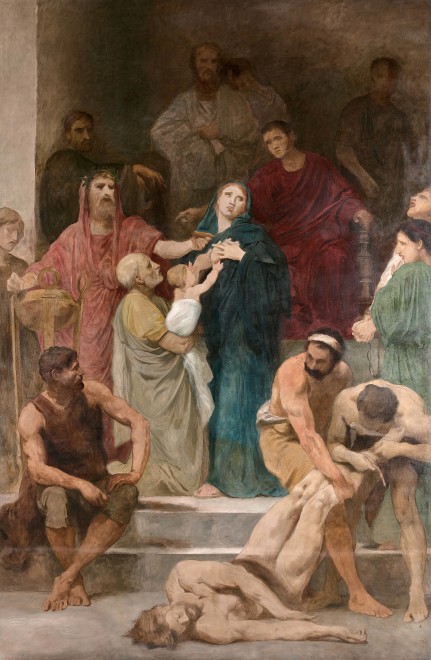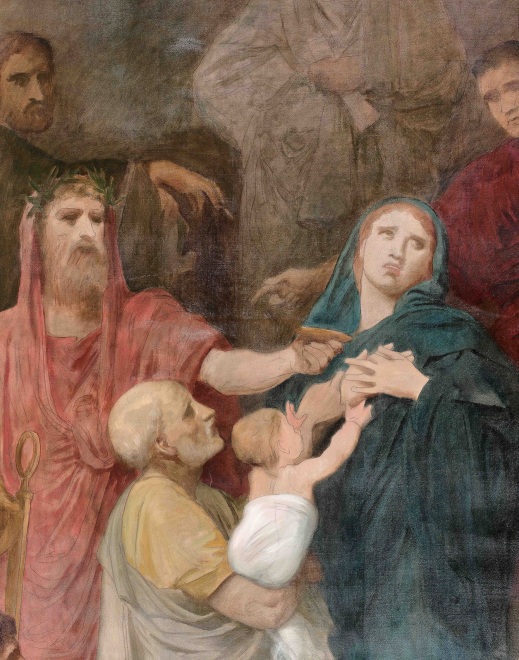Provenance
The Artist’s Studio
The descendants of the artist
Literature
“The Art of the Age,” Pearson’s Magazine, vol. IX, no. 49, January 1900, p. 96
Damien Bartoli with Fred Ross, William Bouguereau: His Life and Works, New York, 2010, pp. 274, 502
Catalogue note
William Bouguereau often worked on three or four paintings simultaneously. In an 1891 interview in L’Éclair, he provided the following commentary: “ I work all day long, without any breaks…I never work on one picture only but have three or four in progress in my studio; that way, if a model doesn’t turn up one day, I don’t have to sit around with my hands in my pockets, I can work on the others.” (William Bouguereau, quoted in “M. Bouguereau chez lui” in L’Éclair, 9 May 1891, translated in William Bouguereau, exh. cat, Paris, 1984, p. 75). However, not all Bouguereau paintings ended up in exhibitions or sold to collectors, a few remained in his studio. Indeed, in a later interview in Pearson’s Magazine from January 1900, Bouguereau spoke specifically about the challenges he faced with one of his monumental paintings – Sainte Perpétue: “That is a picture over which I worked for twenty years,” said the master, “but which I have never been able to finish. Somehow or other, it never would come right. I still am trying at it, for the story of Sainte Perpétue is a noble one, and the subject pleases me much. The Romans wish the noble lady to recant, they do not wish her to suffer, and you see they have brought her baby child to plead to his mother that she will not let herself be taken away from him.” (Pearson’s Magazine, January 1900, p. 96.) While we may never know exactly how the painting appeared when Bouguereau was interviewed in 1900; had he continued to work on it up until his last years in the early 1900s? What we do know is that Sainte Perpétue remained in Bouguereau’s studio, never finished and was recently discovered rolled up against the wall, behind another painting.
Sainte Perpétue may be dated as early as 1877. In a letter from a woman named Pauline de Damas (Bartoli and Ross, p. 274) dated 6 November 1877 to Bouguereau’s daughter, Henriette, she inquired about the progress on Sainte Perpétue, La Charité and La nymphée; the latter two works were both completed for exhibition and sale in 1878. This is the period of most of Bouguereau’s large scale and primarily sacred paintings – Pietà, 1876 (Private Collection, USA), La charité, 1878 (Private Collection, UK), Flagellation, 1880 (La Rochelle Cathedral, La Rochelle, France), La Vierge aux Anges, 1881 (Forest Lawn Cemetery, Glendale, California) and Alma Parens, 1883 (Private Collection). As Louise d’Argencourt has noted: “it has come down by word of mouth that, in order to expiate himself in the eyes of his mother-a very austere and pious woman- for having painted frivolous subjects, and for a great deal of money, the artist promised to execute one religious work a year in atonement for his success.” (Louise d’Argencourt, William Bouguereau-1825-1906, Paris, 1984, exh. cat., p. 94). Was Sainte Perpétue intended to be one of Bouguereau’s repentant paintings?
Saint Perpetua was a third century Christian martyr who died at the games in the amphitheater of Carthage for refusing to denounce her faith. In Bouguereau’s painting, Perpetua is shown surrounded by Roman officials; her father holds up her infant child, pleading with her to abandon her devotion to Jesus Christ. The tethered man in the lower right of the painting does not specifically appear in the story of St. Perpetua. He may be another Christian martyr, possibly a fictional adaption of the story by Bouguereau to display his skill in rendering the male form. As Louise d’Argencourt has pointed out, this figure is similar to the body of Jesus Christ in The Flagellation.
As a devout Catholic, Bouguereau always would have heard the celebrant invoke Saint Perpetua’s name in the Roman Canon of the Mass, and clearly, he found inspiration in the account of this young martyr. However, unlike the most frequently depicted and recognizable Biblical and sacred subjects, St. Perpetua had no visual precedents in the art of prior centuries. In other words, Bouguereau started from scratch when he decided to paint Saint Perpetua. This is not to say that Bouguereau was a copyist when he painted sacred themes such as The Crucifixion or The Flagellation, or even his many depictions of the Blessed Virgin with the Christ Child, however, he could not ignore prior interpretations as these subjects already had been painted by the most famous names in European art history.
We understand from his own words that Bouguereau had hoped to finish his painting of Saint Perpetua, but let’s not forget the beauty that can also be found in an unfinished work of art – “as philosophically rich as it is aesthetically rewarding,” as quoted in The Boston Globe in their review of the 2016 exhibition, Unfinished: Thoughts left Visible at The Metropolitan Museum of Art.




